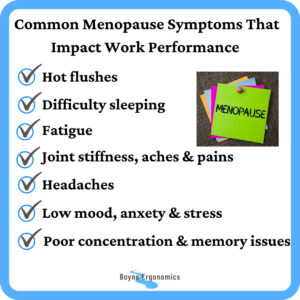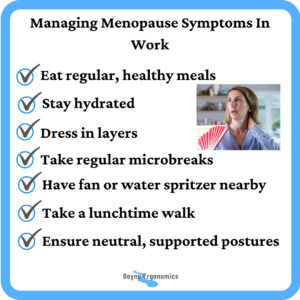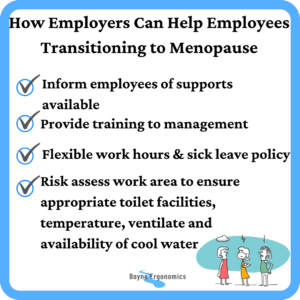For this blog post, I will be looking at how Ergonomics and Human Factors can be used to help employees transitioning to the menopause manage their symptoms in the workplace, reducing their risk of discomfort, injury and stress and improving their productivity and wellbeing. I will also be advising how employers can help facilitate this cohort, helping them retain the talent and experience that these employees offer.
According to the 2019 ESRI Report titled “Ageing Workforce in Ireland – Working Conditions, Health and Extending Working Lives” by, the percentage of the workforce aged over 50 years will increase from 26% (in 2016) to 32% in 2031. The ageing workforce brings with it many Health & Safety considerations for employers. In 2018, females over 55 years comprised 12% of the labour force.

How Can Ergonomics and Human Factors Help?
Ergonomics and Human Factors focuses on designing and adapting to ensure that the product, task, equipment and environment suit the end user. In the case of the workplace, the work equipment, environment and processes that were in place prior to the onset of menopausal symptoms may no longer be suitable, increasing the risk of stress, discomfort and injury.
By adapting the workplace and tasks to accommodate and even reduce the effects of menopausal symptoms, we can facilitate employees to work to the best of their abilities while going through the transition.

What is the Menopause?
The menopause refers to the reproductive age when the ovaries lose their biological function and periods have stopped. It is usually confirmed when the woman has not had a period for 12 months. It commonly beings between the ages of 45 – 55 but the transition can start earlier, even in the mid-30s, with a change in hormone levels known as peri-menopause.
The range and severity of menopause symptoms experienced by women varies greatly, with the HSE estimating that 80% of women will experience symptoms during the transition to the menopause, with 45% of this reporting difficulty managing these symptoms.
Ireland’s dedicated menopause clinic, The Menopause Hub, reports that 77% of women surveyed in October 2021 experienced moderate / severe menopause symptoms, with 22% of these missing 3+ days of work due to these symptoms and 43% reporting that their symptoms were so severe that they have considered giving up work.
Common Menopausal Symptoms That Can Impact Work
The common symptoms of perimenopause and menopause that can impact employees in the workplace include:
- Hot flushes
- Night sweats
- Sleep difficulties
- Heavy periods
- Fatigue
- Headaches
- Low mood, anxiety & stress
- Loss of concentration & memory issues
- Joint stiffness, aches & pains
- Reduced muscle mass
- Decreased bone density / osteoporosis

Employee Experience of Menopause at Work
The INMO Draft Position Statement on Menopause At Work, May 2019, cited research from the British Occupational Health Research Foundation in 2011 that explored employee’s experiences of working while going through the menopause transition. What they found, in summary, was:
- Most women were not prepared for the onset of menopausal symptoms.
- Over half did not disclose their symptoms to their managers and were not comfortable to do so.
- The majority felt that they would benefit from more support in the workplace.
- Workplaces and workplace practices were not designed with consideration for menopausal employees.
- Employee’s going through the menopausal transition experienced low self confidence and embarrassment related to heavy periods, hot flushes, mood disturbances, fatigue and poor concentration.
- If employees required time off work, only half disclosed the reason to their manager.
- Some employees felt they had to work harder to overcome the difficulties associated with their symptoms.
- Some employees considered changing to part-time but worried about the impact on their career.
- Some employees considered leaving the workforce.
- Over half reported that they could not negotiate flexible work hours or work practices to help with managing the symptoms.
- Temperature in the workplace, and lack of control over temperature and ventilation was cited as an issue.

How Can Employees Manage Their Symptoms In Work?
To help reduce the impact of menopausal symptoms in the workplace, employees should focus on staying mobile, adopting supported and neutral postures, maintaining energy levels, maintaining comfortable body temperature, ensuring adequate hydration and ventilation and liaising with management to ensure workload is manageable and flexible.
Fatigue:
Eat regular, healthy meals & stay hydrated to help maintain energy levels during the day.
Take a walk at lunchtime.
Keep an open dialogue with your manager to discuss flexible working hours, working from home or reduction in workload as required.
Hot flushes:
Dress in layers that can be removed or put on as needed.
Keep a fan or water spritzer nearby.
Keep a change of clothes at work if onsite.
Ensure your workspace is well ventilated.
Take a walk at lunchtime.
Joint stiffness, aches & pains
Ensure appropriate workstation set up for your equipment and your stature. Sit at a height that allows your elbows to be level with the work surface when your shoulders are relaxed, make sure your feet are planted on a solid surface and lower back is supported. Set screen height so your eyeline rests on the top 1/3 when you are sitting upright with neck neutral and keep keyboard and mouse close to you.
Take regular microbreaks from the workstation, getting up from the desk at least once every 45 minutes.
Practice safe and appropriate manual handling techniques and postures.
Avoid manual handling tasks that you feel are beyond your abilities.
Low mood, anxiety & stress
Keep an open dialogue with your manager to discuss flexible working hours, working from home or reduction in workload.
Take a walk at lunchtime.
If working from home, set up a dedicated work area in your home that can be out if sight when you are not working eg spare room, closed off behind room screen or cleared away at the end of the day.

How Can Employers Support Employees Experiencing Symptoms Associated With Peri / Menopause?
To help reduce stress, discomfort and injury risk among their employees experiencing menopausal symptoms, employers should focus on developing an open and inclusive work environment that is sensitive to the needs and abilities of this cohort.
Ensure managers have training to understand how the menopause can affect work and the adjustments that may be needed to support employees experiencing symptoms.
Flexible working arrangements to allow for breaks when required. Employees should not be penalised for toilet breaks.
Guidance on how to deal with the menopause should be freely available as part of the company occupational health awareness.
Information on supports available and how these can be accessed should be available to staff.
Flexible sickness absence policy to cater for menopause-related symptoms, e.g. recording absence related to menopausal symptoms as an ongoing long term issue as opposed to individual short-term absences.
Workplace risk assessments should consider temperature, ventilation, toilet facilities and access to cool drinking water.
Focusing on creating an inclusive work environment will help employers retain valuable experience and talent.



